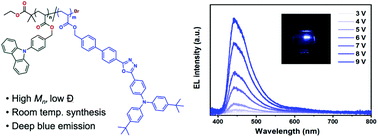Cu(0)-RDRP as an efficient and low-cost synthetic route to blue-emissive polymers for OLEDs†
Abstract
Polymer-based emitters are a promising route to inexpensive, large-area solution-processed polymer light-emitting diodes (PLEDs). By preparing devices via wet processing methods such as spin-casting or blade-coating, it is possible to generate large panels without costly high-vacuum evaporation. Wet processing typically benefits from the use of high molecular weight materials with hydrophobic moieties, in order to facilitate the formation of high-quality films as well as to inhibit crystallization and aggregate formation. Here we show that recently developed Cu(0) reversible deactivation radical polymerization (RDRP) procedures can be used to generate high molecular weight copolymers (Mn > 20 kDa) with dispersities <1.2 for use as emitters in PLEDs, using a simple and inexpensive procedure at room temperature using Cu(0) wire as catalyst. By copolymerizing an acrylic host monomer with a high quantum yield fluorescent emitter, copolymers can be quickly obtained that are suitable for use as all-in-one emissive layers for PLEDs. These emissive polymers demonstrate blue emission with high quantum yield (up to 100%) while also forming high quality films when cast from solution. Furthermore, the utility of these polymeric emissive materials was demonstrated in proof-of-concept devices prepared by spin-coating, with EQE up to 2.63% and CIE coordinates of (0.16, 0.15). These methods represent extremely low-cost routes to well-defined polymers for PLEDs and can be easily adapted to the preparation of second- and third-generation emissive materials.



 Please wait while we load your content...
Please wait while we load your content...